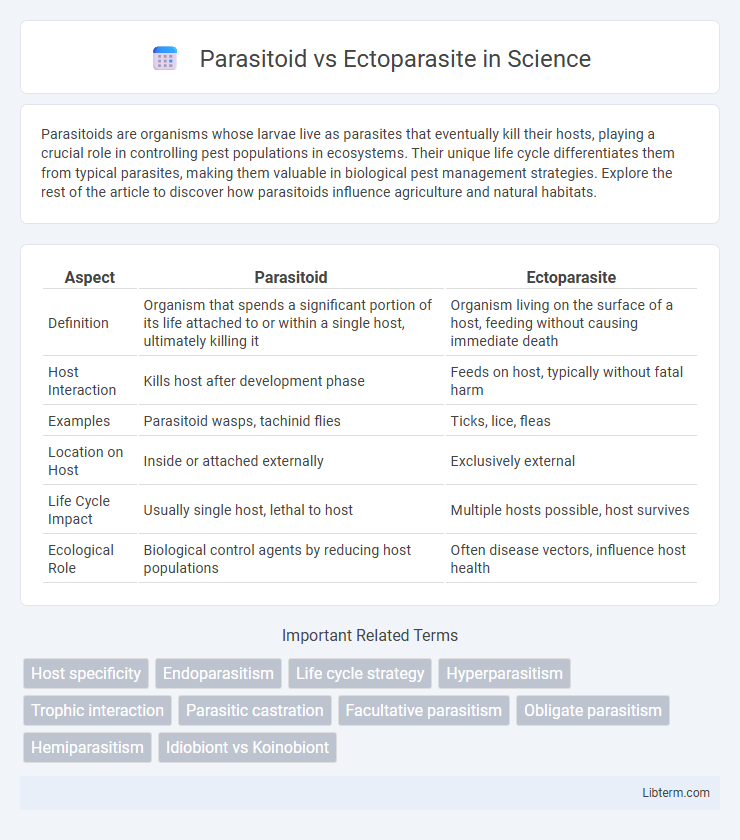Parasitoids are organisms whose larvae live as parasites that eventually kill their hosts, playing a crucial role in controlling pest populations in ecosystems. Their unique life cycle differentiates them from typical parasites, making them valuable in biological pest management strategies. Explore the rest of the article to discover how parasitoids influence agriculture and natural habitats.
Table of Comparison
| Aspect | Parasitoid | Ectoparasite |
|---|---|---|
| Definition | Organism that spends a significant portion of its life attached to or within a single host, ultimately killing it | Organism living on the surface of a host, feeding without causing immediate death |
| Host Interaction | Kills host after development phase | Feeds on host, typically without fatal harm |
| Examples | Parasitoid wasps, tachinid flies | Ticks, lice, fleas |
| Location on Host | Inside or attached externally | Exclusively external |
| Life Cycle Impact | Usually single host, lethal to host | Multiple hosts possible, host survives |
| Ecological Role | Biological control agents by reducing host populations | Often disease vectors, influence host health |
Introduction to Parasitoids and Ectoparasites
Parasitoids are organisms, typically insects like certain wasps and flies, whose larvae develop inside or on a host, ultimately leading to the host's death, distinguishing them from typical parasites. Ectoparasites, such as ticks and lice, live on the surface of their host and usually do not kill the host, relying instead on prolonged feeding for survival. The fundamental difference lies in the parasitoid's lethal relationship with its host compared to the generally non-lethal, surface-bound interaction of ectoparasites.
Defining Parasitoids: Key Characteristics
Parasitoids are organisms whose larvae develop inside or on a single host organism, ultimately killing it, distinguishing them sharply from ectoparasites that live on the host's surface without necessarily causing death. Key characteristics of parasitoids include a life cycle involving a parasitic larval stage, host specificity, and a fatal outcome for the host, often seen in many wasp and fly species. Unlike ectoparasites, which may feed on blood or tissue and coexist with their hosts, parasitoids ensure host death by consuming vital tissues from within.
Defining Ectoparasites: Key Characteristics
Ectoparasites are organisms that live on the external surface of their host, deriving nutrients by feeding on blood, skin, or other bodily fluids. Key characteristics include their ability to remain attached to the host, often possessing specialized mouthparts or claws for gripping, and a life cycle closely tied to the host's environment. Unlike parasitoids, which typically kill their hosts, ectoparasites usually maintain host viability to ensure continual access to resources.
Life Cycle Differences Between Parasitoids and Ectoparasites
Parasitoids undergo a life cycle where their larvae develop inside or on a single host, eventually killing it during maturation, unlike ectoparasites that live externally on multiple hosts without typically causing host death. Parasitoid development often involves a complete metamorphosis, including egg, larval, pupal, and adult stages tightly linked to host availability and condition. Ectoparasites maintain a prolonged, external feeding relationship with their hosts through iterative molts across life stages, emphasizing survival and reproduction without immediate host mortality.
Host Interaction: How Parasitoids Attack vs. Ectoparasites Feed
Parasitoids lay their eggs inside or on the surface of a living host, with larvae consuming the host from within, ultimately leading to the host's death. In contrast, ectoparasites attach externally to the host's body, feeding on blood or bodily fluids without necessarily killing the host. Parasitoid-host interactions involve a lethal developmental relationship, while ectoparasite-host interactions are typically non-lethal and rely on prolonged attachment for nourishment.
Ecological Roles and Impact on Host Populations
Parasitoids play a crucial ecological role by regulating host populations through a lethal interaction where the host is eventually killed, significantly reducing pest species and influencing community dynamics. Ectoparasites, in contrast, typically weaken their hosts by feeding externally without direct lethality, often leading to decreased host fitness and increased vulnerability to secondary infections. Both strategies impact host population dynamics differently, with parasitoids serving as biological control agents and ectoparasites contributing to host stress and disease transmission.
Evolutionary Adaptations: Survival Strategies
Parasitoids exhibit evolutionary adaptations that enable them to inject their eggs directly into or onto a host, ensuring larval development within or on a single host organism, often leading to the host's death, which maximizes offspring survival. Ectoparasites have evolved specialized structures such as claws and mouthparts to securely attach to the external surface of hosts, allowing prolonged feeding while minimizing detection and host immune response. These survival strategies reflect distinct evolutionary pathways where parasitoids depend on host exploitation for larval growth, whereas ectoparasites maintain a more sustainable relationship by feeding externally without immediate host lethality.
Examples of Common Parasitoids and Ectoparasites
Common parasitoids include the ichneumon wasps and tachinid flies, which lay their eggs on or inside host insects, eventually killing them. Notable ectoparasites are ticks, lice, and fleas, which live on the surface of their hosts and feed on their blood or skin. Both parasitoids and ectoparasites play significant roles in ecological balance and pest control strategies.
Importance in Biological Control and Disease Transmission
Parasitoids play a crucial role in biological control by effectively reducing pest populations through their lethal parasitism, making them valuable agents in integrated pest management programs. Ectoparasites, while often detrimental due to their ability to transmit pathogens and diseases to hosts, also influence ecosystem dynamics and can indirectly affect pest control outcomes. Understanding the distinctions between parasitoid and ectoparasite behaviors enhances strategies for disease management and sustainable agriculture.
Conclusion: Comparing Parasitoid and Ectoparasite Dynamics
Parasitoids typically kill their hosts as part of their life cycle, while ectoparasites feed on hosts without immediate lethality, enabling prolonged parasitic relationships. Parasitoid dynamics often result in host population control, contrasting with ectoparasites that can cause chronic stress or disease in hosts. Understanding these distinctions highlights their ecological roles and impacts on host survival and ecosystem stability.
Parasitoid Infographic

 libterm.com
libterm.com